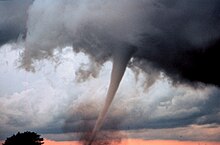Tornado
| Subject classification: this is a science resource. |
A tornado is a tube of violently spinning air that touches the ground. Wind inside the tornado spins fast, but the actual 'circle' of wind around them is massive. This makes tornadoes dangerous.[1] Tornadoes are especially dangerous to people in cars or mobile homes.


Tornadoes mostly happen during strong thunderstorms called supercell storms. They cause a lot of damage to anything in the path. Tornadoes are ranked on the Fujita scale, from F0 to F5. The F0 has the lowest wind speed, and the F5 has the highest one.
Tornadoes can happen in nearly any part of the world. In the United States, a tornado has been created in all states. The middle part of the United States is nicknamed 'Tornado Alley' for the large number of tornadoes created there.
A tornado does not necessarily need to be visible; however, the extremely low pressure caused by the high wind speeds and rapid rotation usually causes water vapor in the air to condense into a visible condensation funnel. The tornado is the vortex of wind, not the condensation cloud.
A single storm may produce multiple tornadoes and mesocyclones. Tornadoes produced from the same storm are referred to as a tornado family. Sometimes multiple tornadoes from distinct mesocyclones occur at the same time.[2]
Tornado outbreak
editOccasionally, several tornadoes are spawned from the same very large storm. If there is no break in their activity, this is considered a tornado outbreak, although there are various definitions. A period of several successive days with tornado outbreaks in the same general area (spawned by multiple weather systems) is a tornado outbreak sequence, occasionally called an extended tornado outbreak.[1][3]
References
edit- ↑ 1.0 1.1 "Glossary of Meteorology, Second Edition". American Meteorological Society. 2000. Retrieved 2006-11-17.
- ↑ Branick, Michael (2006). "A Comprehensive Glossary of Weather Terms for Storm Spotters". NOAA. Retrieved 2007-02-27.
- ↑ Dylan J. Livengood; Harold E. Brooks; Joseph T. Schaefer (2004). "Tornado Outbreak Day Sequences: Historic Events and Climatology (1875–2003)" (PDF). Retrieved 2007-03-20.